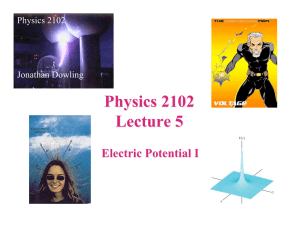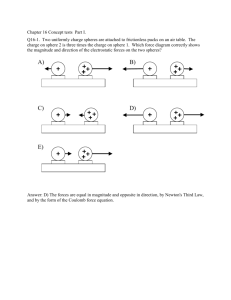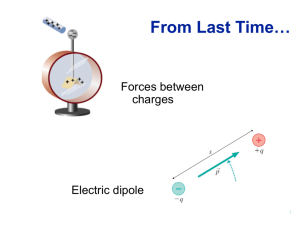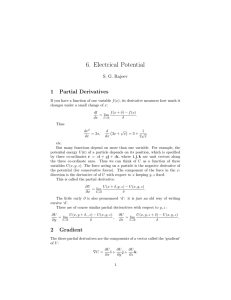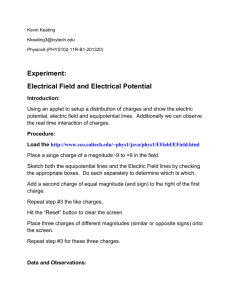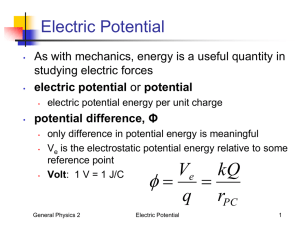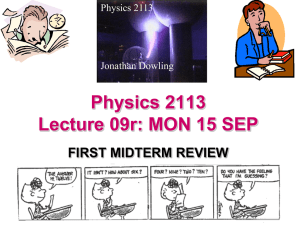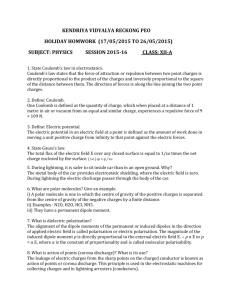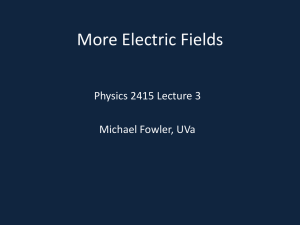PPT
advertisement
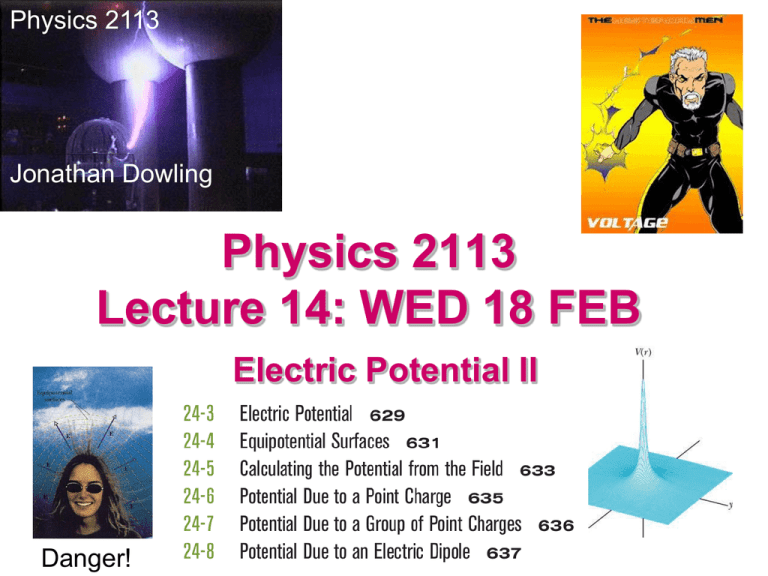
Physics 2113 Jonathan Dowling Physics 2113 Lecture 14: WED 18 FEB Electric Potential II Danger! Units : Electric Potential Energy, Electric Potential Potential Energy = U = [J] = Joules Electric Potential = V = U/q = [J/C] = [Nm/C] = [V] = Volts Electric Field = E = [N/C] = [V/m] = Volts per meter F = qE (Force is charge times Field) U = qV (Potential Energy is charge times Potential) Electron Volt = 1eV = Work Needed to Move an Electron Through a Potential Difference of 1V: W = qV = e x 1V = 1.60 10–19 C x 1J/C = 1.60 10–19 J Electric Potential Energy = Joules Electric potential energy difference U between two points = work needed to move a charge between the two points: U = Uf – Ui = –W Electric Potential Voltage = Volts = Joules/Coulomb! Electric potential — voltage! — difference V between two points = work per unit charge needed to move a charge between the two points: V = Vf – Vi = –W/q = U/q Equal-Potential = Equipotential Surfaces • The Electric Field is Tangent to the Field Lines • Equipotential Surfaces are Perpendicular to Field Lines • Work Is Needed to Move a Charge Along a Field Line. • No Work Is Needed to Move a Charge Along an Equipotential Surface (Or Back to the Surface Where it Started). • Electric Field Lines Always Point Towards Equipotential Surfaces With Lower Potential. Electric Field Lines and Equipotential Surfaces Why am I smiling? I’m About to Be Struck by Lightning! http://www.cco.caltech.edu/~phys1/java/phys1/EField/EField.html Conservative Forces The potential difference between two points is independent of the path taken to calculate it: electric forces are “conservative”. Electric Potential of a Point Charge Bring imaginary + test charge q0 in from infinity! Note: if q were a negative charge, V would be negative If q0 and are both + charges as shown, is the Work needed to bring q0 from ∞ to P + or –? Electric Potential of Many Point Charges • Electric potential is a SCALAR not a vector. q4 • Just calculate the potential due to each individual point charge, and add together! (Make sure you get the SIGNS correct!) qi V = åk ri i r3 r4 q5 r5 Pr2 q2 r1 q1 q3 3 D = 2d For speed set d = e = 1! æ +e +e ö 3 e (a) VP = ç + ÷ = = 3/2 è d 2d ø 2 d æ +e +e ö 3 e (b) VP = ç + ÷ = = 3/ 2 è d 2d ø 2 d æ +e +e ö 3 e (c) VP = ç + ÷ = = 3/2 è d 2d ø 2 d V (a) P =V (b) P =V (c) P No vectors! Just add with sign. One over distance. Since all charges same and all distances same all potentials same. qi V = åk ICPP: ri i Positive and negative charges of equal magnitude Q are held –Q +Q in a circle of radius r. 1. What is the electric potential voltage at the center of each circle? • VA = • VB = • VC = k(+3Q - 2Q) /r = +kQ/r A k(+2Q - 4Q) /r = -2kQ/r k ( +2Q - 2Q ) / r = 0 2. Draw an arrow representing the approximate direction of B the electric field at the center of each circle. 3. Which system has the highest potential energy? UA =+q0VA has largest positive un-canceled charge C Potential Energy of A System of Charges • 4 point charges (each +Q and equal mass) are connected by strings, forming a square of side L • If all four strings suddenly snap, what is the kinetic energy of each charge when they are very far apart? +Q +Q +Q +Q • Use conservation of energy: – Final kinetic energy of all four charges = initial potential energy stored = energy required to assemble the system of charges – If each charge has mass m, find the velocity of each charge long after the string snaps. Let’s do this from scratch! Potential Energy of A System of Charges: Solution • No energy needed to bring in first charge: U1=0 +Q • Energy needed to bring in 3rd charge = kQ 2 kQ 2 U 3 = QV = Q(V1 + V2 ) = + L 2L • Energy needed to bring in 4th charge = 2kQ 2 kQ 2 U 4 = QV = Q(V1 + V2 + V3 ) = + L 2L +Q 2L • Energy needed to bring in 2nd charge: kQ 2 U 2 = QV1 = L L +Q +Q Total potential energy is sum of all the individual terms shown on left hand side = 2 ( kQ 4+ 2 L ) So, final kinetic energy of each charge =K=mv2/2 = 2 ( kQ 4+ 2 4L ) Potential Energy of a Dipole DU = Wapp = qDV +Q a What is the potential energy of a dipole? –Q +Q a –Q • First: Bring charge +Q: no work involved, no potential energy. • The charge +Q has created an electric potential everywhere, V(r) = kQ/r • Second: The work needed to bring the charge –Q to a distance a from the charge +Q is Wapp = U = (-Q)V = (–Q)(+kQ/a) = -kQ2/a • The dipole has a negative potential energy equal to -kQ2/a: we had to do negative work to build the dipole (electric field did positive work). Electric Potential of a Dipole (on axis) What is V at a point at an axial distance r away from the midpoint of a dipole (on side of positive charge)? V =k Q -k Q a a (r - ) (r + ) 2 2 a a ö æ ç (r + 2 ) - (r - 2 ) ÷ = kQ ç ÷ a a ç (r - )(r + ) ÷ è 2 2 ø Qa = 2 a 2 4pe 0 (r - ) 4 p a –Q +Q r Far away, when r >> a: V = p 4pe 0 r 2 IPPC: Electric Potential on Perpendicular Bisector of Dipole You bring a charge of Qo = –3C from infinity to a point P on the perpendicular bisector of a dipole as shown. Is the work that you do: a) Positive? b) Negative? c) Zero? U = QoV = Qo(–Q/d+Q/d) = 0 a -Q +Q d P –3C 4 Pa Va = + Vb = 0 Vc = - Pb Pc Va > Vc > Vb Summary: • Electric potential: work needed to bring +1C from infinity; units V = Volt • Electric potential uniquely defined for every point in space -independent of path! • Electric potential is a scalar — add contributions from individual point charges • We calculated the electric potential produced by a single charge: V=kq/r, and by continuous charge distributions: dV=kdq/r • Electric potential energy: work used to build the system, charge by charge. Use W=qV for each charge. Midterm Exam #1 • • • • • • AVG = 67; STDV=17 A: 90-100% B: 75-89% C: 60-74% D: 50-59% F: 49-0%

